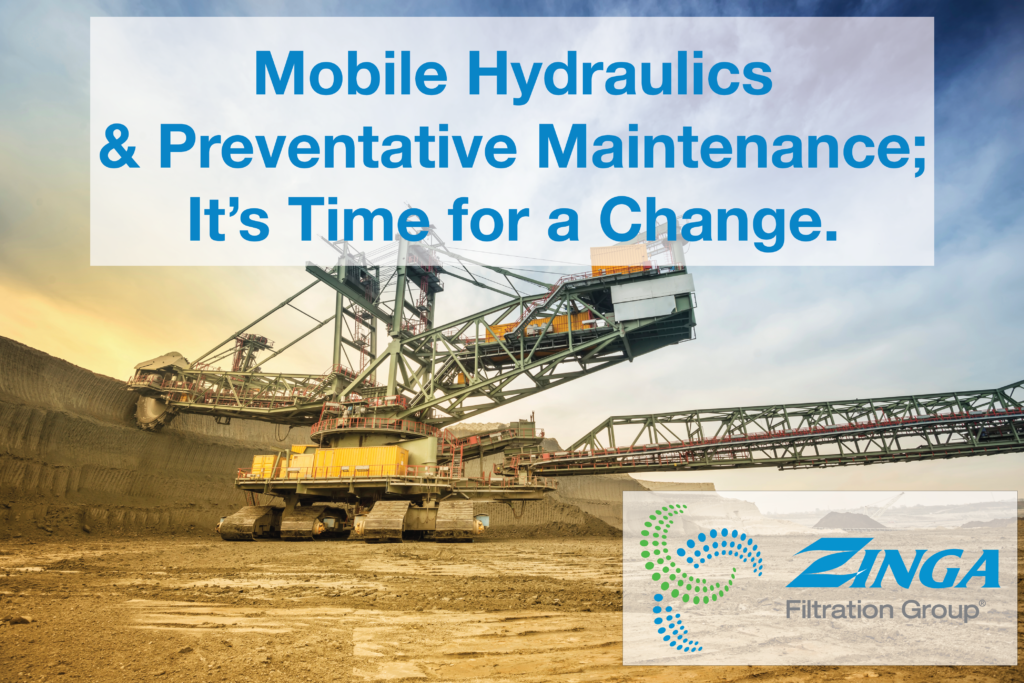Mobile Hydraulics & Preventative Maintenance; It’s Time for a Change.

Current heavy equipment operates at a rate far faster than it used to only a little while earlier, because of the innovation and technology growth for the parts that go into building them. But with their extreme environments and narrow margins for system error these over engineered, and highly efficient parts demand maintenance professionals focus on their upkeep and service, or they will most certainly fail.
Maintaining hydraulic fluid is simple in theory, you must maintain a reasonable temperature while minimizing contamination and moisture. But in practice, this requires attention to detail, a good understanding of how your system is operating, and time. When neglected, cylinders cease, lines will burst, and progress as well as profit will stop. A fading train of thought centers around heavy equipment hydraulic systems being tightly sealed and that their filters for that system will stay clean in between maintenance cycles, this just isn’t true and at Zinga, we are happy to see that others are realizing just how detrimental this type of thinking can be. Particulate contamination and moisture ingression are extremely real threats, and as an industry we are moving past “if we can’t see it, then it isn’t there”, when it comes to heavy equipment. Everyday use is going to create it’s own opportunities for ingression and the most common hydraulic fluids are created to break down and be replaced. But there are a lot of other ways particulate contamination and moisture ingression can occur. Here are just a few to think about…
Around Your Environment
Is your system leaking at all? If your system has a site for fluid expression, then you have a haven for ingression every time. What about your fluid transferring equipment and accessories? Are their surfaces free from particulate contamination, is your fluid being cleaned prior to or after it is placed in its distribution reservoir? When was the last time you flushed your hoses, and what did you use to do so? These are all great opportunities for particulate contamination and moisture ingression within your system.
Switching out tooling accessories, more importantly the maintenance of accessory attachment fittings, is another large and sometimes overlooked opportunity for particulate contamination and moisture ingression. How many times have we seen these tools dropped and left on their hoses/fittings in the dirt until needed the next time? New practices recommend “bagging” fittings when not in use and are “operator level” maintenance requirements when referring to most major manufacturer’s literature.
Finally, topping off is an opportunity for cross contamination, but is also a clear sign of leaking. If you must top off your system, be sure to follow manufacturer recommendations and be consistent with brand and blend when replacing.
Inside Your System
When heavy equipment is working perfectly, it is still a bunch of metal parts grinding around on one another, and hydraulic fluid will always be a magnet for the particulate contamination that your system will inherently create. Brand new equipment is shipped with brand new fluid, but as we all know, new does not mean clean. This might not be a large reason for concern, but it is a needle on this preverbal camel’s back. Zinga strongly recommends sampling and analyzing new equipment fluids. This will not only jumpstart your process of understanding and documenting maintenance with your new piece of equipment but will also allow valuable insight that could prevent unexpected downtime.
Speaking of unexpected downtime; the types of events that cause unexpected downtime are also events that are most likely to increase particulate contamination and moisture ingression. If a hose bursts or a bearing seal fails, their byproducts will end up in the system with their absence creating a point for major ingression.
Finally, fluid oxidation and breakdown. With fluctuating temperatures created by equipment’s normal use and by the friction caused by particulate contamination and subpar filtration, hydraulic fluid will begin to breakdown. As it does its byproducts, foam and varnish formation, can be detrimental to systems if left untreated. Another reason Zinga recommends fluid sampling and analyzation often (every 200 – 250 hours). A schedule based on this recommendation keeps maintenance professionals in-touch with their equipment and adds vital data needed to identify and correct negative trends in a timely manner. The types of analyzation Zinga recommends is both ISO cleanliness (contamination) testing and “Karl-Fischer” or water presence testing. Both are common tests and can be conducted within most testing laboratories.
In Conclusion
Take the time to get to know your new equipment, or to get reacquainted with what you have been working around for years by using testing and preventative maintenance. To keep you and your customers equipment moving forward, call on Zinga, your trusted name for filtration solutions for over 45 years.
